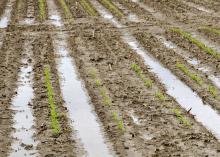Information Possibly Outdated
The information presented on this page was originally released on April 19, 2013. It may not be outdated, but please search our site for more current information. If you plan to quote or reference this information in a publication, please check with the Extension specialist or author before proceeding.
Spring rains help summer crops, but more is needed
MISSISSIPPI STATE – Springtime’s soggy fields are no guarantee that summer’s row crops will have the moisture they need to thrive until harvest in the fall.
Jason Krutz, irrigation specialist with the Mississippi Agricultural and Forestry Experiment Station, said winter and spring rain helps recharge the soil profile, but moisture must be replenished during the growing season.
“In the Delta in the summer, we’re always 10 days from a drought,” Kurtz said. “If you go 10 days without rain, your row crops are in trouble and you will have to irrigate.”
Water infiltrates or seeps into the soil when it falls as rain or irrigation. Scientists use the term “soil profile” to describe the ground layers. The rooting zone is the first 3 to 5 feet of this soil profile.
“We need winter rains to recharge the soil profile all through the rooting zone so that when the plant roots get there, the water is there,” Kurtz said.
Water is stored in soil in the space between soil particles. Krutz said about 50 percent of the soil profile is space that can be filled with water. Soils are described as saturated when water fills all the extra space.
“You can imagine soil like a sponge. Field capacity is when it is full of water but doesn’t drip out,” Krutz said.
Farmers try to plant when soils are at field capacity. Once plants emerge from seed, properly moist soil has sufficient supplies of water to sustain growth for a time. Solar radiation -- bright, sunny days -- wind and heat also speed up water loss through evaporation.
“A small plant uses less water than one that has grown and is mature, and plants use less water on days that are not sunny and bright,” Krutz said.
Ideally, crops planted on time into soil with moisture at field capacity should not need rain or irrigation until the plants reach reproductive stages, usually 30 to 50 days after emergence.
At peak water demand stages, which is typically when grain is filling out, Mississippi crops all require about a quarter of an inch of water a day.
“We want the lower part of the soil profile charged up with as much water as it can hold,” Krutz said. “That way, we have a reservoir of water in the lower soil profile, keeping us from having to irrigate earlier than normal.”
Larry Oldham, Extension soil specialist, said fields need a lot of rain or irrigation, but standing water is not good.
“This indicates a couple of not-too-good outcomes,” Oldham said. “The field may have drainage issues, preventing excess water from moving away, or the soil is saturated, and there is no air in the soil for plants. This hurts germination and decreases the growth of most plants.”
With the exception of rice, which requires a time of controlled flooding during its growth, Mississippi’s row crops can survive from a few days to as much as a few weeks in standing water or saturated soils before damage is done.
“The characteristics of soil in a particular place determines how much runs off into a ditch, is absorbed into the soil or seeps through the soil profile and into groundwater,” Oldham said.





